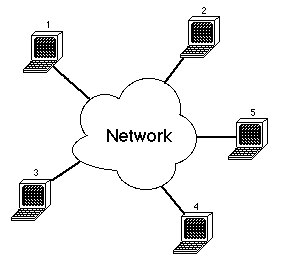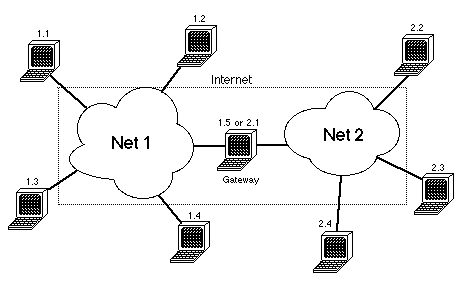
Fig. 23.1.1: Cloud diagram for a network; each computer is a host
No computer exists in isolation today. Computers that scientists use in Antarctica to plot temperature trends under the ozone layer hole communicate via satellite to large data banks in North America. TV commercials show a guy driving into the mountains, hiking onto a scenic peak overlooking a vast golden canyon, and connecting his cellular phone to his laptop computer and checking up on his stock portfolio. Moms and Dads send email to their newly liberated children away at college their first year.
However, the technology that makes it possible for computers to "talk" to each other is vast and intricate, depending upon a bewildering variety of standards, protocols and software packages. We can only get a tiny feel for this labyrinthine world in this chapter, for indeed whole courses are devoted to networking.
Let's begin with some short definitions. A computer is a more or less self-contained unit of computing hardware, consisting of at least one CPU and many peripherals. These peripherals are connected to the computer by parallel buses or are plugged into the motherboard directly, or use a short serial bus (such as a SCSI bus) that is not more than a few meters long.
A network is a collection of computers, called hosts, and the auxiliary hardware that allows them to transmit data to one another. This hardware may include specialized routing computers, wires, modems, DSU/CSUs and the telephone company. Just as important is the set of software that allows these computers to easily communicate data.
A local area network (LAN) is a small network, usually connecting fewer than 1000 computers which are no more than about a mile apart from each other. Ethernet is a standard technology that is employed to implement a LAN. IBM's token ring is another and there are several others. LANs are suitable for a small company, a single department or a single building (as long as it's not the Empire State Building.)
Larger areas enfolded into a network need a wide area network (WAN). These can be anywhere from one university campus to the entire world, and indeed the Internet is the wide area network par excellence, encompassing hundreds of millions of users, many thousands of networks and lots of computers. The technologies used for WANs are very different from those suitable for LANs.
Fig. 23.1.1 shows the typical "cloud diagram" for a network of any kind, LAN or WAN. The owners or operators of the computers which are connected to the net are less concerned with how the network works than the fact that it does work. The diaphanous blob labeled network represents whatever software and hardware that exists to deliver messages between computers attached to it. In this simple figure, computers are given unique identifying numbers, called addresses, which they use to designate who gets the information they are sending, much as we use telephone numbers or postal addresses.

Fig. 23.1.1: Cloud diagram for a network; each computer is a host
Fig. 23.1.2 shows a use of the cloud network in describing how a gateway works. There are two networks in Fig. 23.1.2, both represented by clouds and named network 1 and network 2. A special computer called a gateway is a member of both networks so it can act as a relayer of messages sent from a computer on one network to another computer on the other network. Addresses of individual computers take the form of net number, period, computer number. The gateway has two numbers because it is on two different networks: 1.5 and 2.1.

Fig. 23.1.2: Wide area network composed of several smaller networks linked by a gateway
If the gateway computer is used solely to relay messages between the networks in both directions, then it could be thought of as part of the underlying network mechanism and we could draw a new cloud boundary that encompassed both nets 1 and 2, as well as the gateway. This is what the dotted line represents in Fig. 23.1.2. Any end-user computer that connects to this new internet isn't concerned at all that there are really two separate networks and a gateway between them, at least until the gateway breaks or fails to keep up with the burden of messages it has to relay! The term internet is not capitalized in this sense because it names a type of entity, namely a connection of smaller networks, whereas the Internet, capitalized, refers to an extremely large, worldwide network, a specific entity.